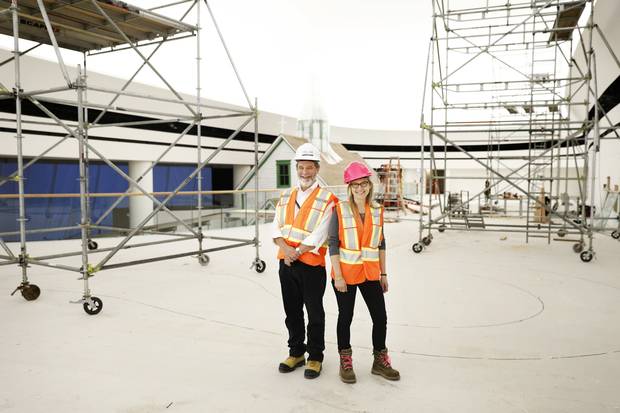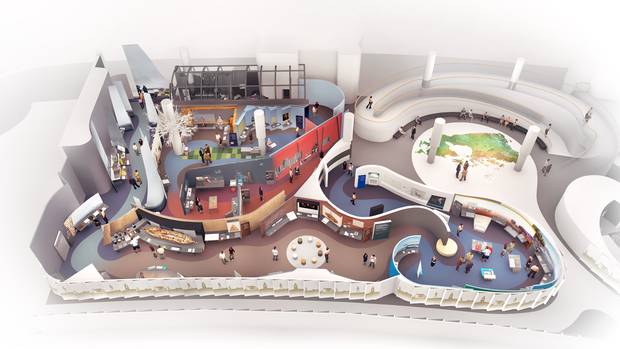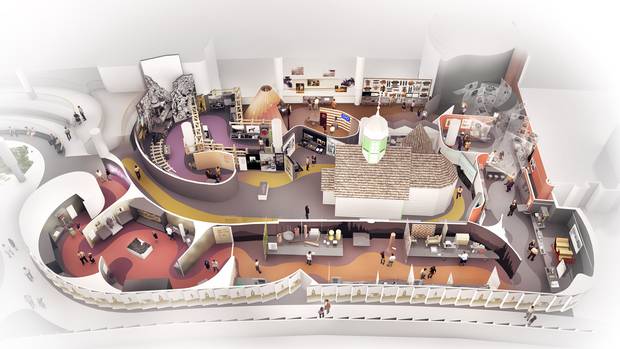
DRAWING BY GSM(DEGREES), CANADIAN MUSEUM OF HISTORY
At the Canadian Museum of History in Gatineau, Que., historians and curators are using a $30-million overhaul to take a nuanced look at the past 13,000 years – from the migrations of the Stone Age to Syrian refugees –
in a new, curvy space.
Daniel Leblanc takes a look
Canada's biggest and most popular museum has 13,000 years of history to tell, and one beautiful curvy space in which to lay it all out.
After debating for years which stories and artifacts to showcase to millions of visitors every year – and which ones to leave out – the small team behind the ambitious $30-million Canadian History Hall is pulling the curtain on its final choices. The starting point was easy – the arrival of the first humans on what is now Canadian soil – but the ending was only recently decided: How Canada welcomed 25,000 Syrian refugees after the election of Justin Trudeau's Liberal government.
In an interview with The Globe and Mail, senior officials at the Canadian Museum of History explained how they approached a task that seemed impossible at first blush: telling a story that includes so many seemingly irreconcilable points of view.
The answer was to strive to offer a comprehensive history of Canada that does not keep European and indigenous narratives separate, as in the old Hall, but rather allows stories from multiple perspectives to exist simultaneously. Regarding the arrival of humans on what is now Canadian territory, for example, the museum will clearly present archeological evidence going back more than 13,000 years. In the same room, the exhibition will present the "creation stories" as told in the voice of six First Nations.
"We have a history that is worthy of preservation, of expression, and within the presentation of that history, there are many perspectives that are extremely important," said the museum's president and chief executive officer, Mark O'Neill. "My hope is that visitors to the exhibition will feel a personal connection to history that they didn't have before."
The exhibition is scheduled to open on July 1, 2017, as part of the celebrations of Canada's 150th birthday.

The $30-million Canadian History Hall, still under construction.
STEVEN DARBY/CANADIAN MUSEUM OF HISTORY

The major exhibition aims to explore 13,000 years of the Canadian experience.
STEVEN DARBY/CANADIAN MUSEUM OF HISTORY
In typically Canadian fashion, the project was born in controversy. The concerns started in the fall of 2012 when the Conservative government of the day – fresh off a long and expensive campaign to instruct Canadians on the War of 1812 – announced that the Museum of Civilization would change its name to the Museum of History. Opposition MPs and academics raised fears the broad mandate of the institution would disappear, to be replaced by a narrow look at milestones of Canada's history that suited the government's agenda.
David Morrison, an archeologist who spent more than 20 summers digging up artifacts in the Canadian north, heard the negative chatter as a small team of historians and curators started gathering ideas for the Canadian History Hall.
"We were aware of fears it would be politicized, but we didn't share them," said Mr. Morrison, the director of research and content for the Hall. "[The government] didn't tell us what to put in it or what to say. They said, 'We want a comprehensive history of Canada, and here's the money to do it.'"

David Morrison and Chantal Amyot survey the new exhibit space at the Canadian Museum of History in Gatineau, Que., on Sept. 15, 2016.
BLAIR GABLE FOR THE GLOBE AND MAIL
The creators of the Canadian History Hall insist it will be totally different than the Canada Hall, which long occupied the same space, going back to the museum's opening in 1989. Anyone who visited the old exhibition can remember the fake, Disneyesque feel of the displays, from a whaling station to a shoemaker's house.
"It was very beautifully done, the reproductions were amazing and they were historically correct, but they weren't real. Our stance is that it's authentic, or it's not there," said Chantal Amyot, who is now overseeing the creation of the new Hall.
Another problem was that the history of First Nations was segregated from that of the European settlers in the old Hall. The new exhibit, on the other hand, will seamlessly weave the two together. By exploring a number of "dark chapters" in such a large-scale project, the museum feels it is going where no one else has dared, Mr. O'Neill said.
"When you decide to look at political history, cultural history, economic history, labour history, women's history, indigenous history, you're taking a big risk because these are very complex, complicated subjects," he said.
The second big change in the new exhibition has been the involvement of Douglas Cardinal, Canada's architect extraordinaire who found inspiration in the Ottawa River when he designed the museum's twin buildings. In the new hall, all the walls are curvy and the stairwell is circular, with a number of open vistas on other exhibitions, such as the Children's Museum.
The Canadian History Hall will be broken down in three distinct galleries: from the beginnings of human presence to the Royal Proclamation of 1763; from 1763 to the start of the First World War; and from 1914 to today.

Gallery 1 contains: Origins (earliest times to 9,000 years ago); Land and People (9,000 years ago to 800 years ago); Indigenous Nations (4,000 years ago to 500 years ago); The Arrival of Europeans (1000 to 1615); Trade, Disease, War (1615 to 1701); New France (1608 to 1763); Transatlantic Rivals (1670 to 1763).
DRAWING BY GSM(DEGREES), CANADIAN MUSEUM OF HISTORY

Gallery 2 contains: British North America (1763 to 1815); English Canada (1784 to 1840); The Western and Northern Fur Trade (1763 to 1851); Making a Country (1840 to 1867); From Sea to Sea (1867 to 1885); Transforming a Dominion (1885 to 1914).
DRAWING BY GSM(DEGREES), CANADIAN MUSEUM OF HISTORY

Gallery 3 contains: Sovereignty and Prosperity (1914 to the present); First Peoples (1885 to the present); Quebec (1960 to the present); Diversity and Human Rights (1914 to the present); An International Canada (1945 to the present).
DRAWING BY GSM(DEGREES), CANADIAN MUSEUM OF HISTORY
The first two galleries are handled in a "chrono-thematic" way, more or less respecting the chronology of the various events. The last gallery, however, looks at broad themes to show "how Canada became a prosperous and sovereign nation, relatively speaking," said Mr. Morrison.
The museum will try out new technologies. For example, it has used forensics to create the facial reconstruction of an 800-year-old "kayak man" from Arctic Bay. Using digital technologies, it has also recreated a 4,000-year-old family in B.C. whose members were buried with 350,000 handmade beads, showcasing tremendous wealth and power.
While the first and second galleries share a single floor, the third gallery occupies the entire mezzanine above, allowing visitors to "look down and see the roots of [their] history," said Ms. Amyot.
Looking at the struggle of indigenous people "for their rights and the preservation of their cultures" since 1885, the hall will delve specifically into the abuses suffered by members of First Nations in residential schools. The present is reflected in the focus on the Idle No More movement and the upcoming inquiry into murdered and missing aboriginal women.
Another central theme of the third gallery is the Canadian Charter of Rights and Freedoms and its broad impact on Canadian society – a key landmark of the Liberal government of Pierre Trudeau. For the first time, for example, the museum will explore the fight for LGBTQ rights. The museum already has the authorization of the Senate to showcase the table on which the Proclamation of the Constitution Act was signed by the Queen and Mr. Trudeau in 1982, but is now looking to get the actual document out of storage.
"There is nothing that can replace the intimate interaction between the visitor and the artifact," Mr. O'Neill said. "We have these incredible objects and artifacts that, in other countries, would be called national treasures."
A couple of other artifacts are due to stand out, even if they are just a few months old. Museum officials recently decided to include the story of the arrival of 25,000 Syrians refugees in late 2015 and early 2016. One artifact that will be displayed is a copy of a Maclean's magazine featuring a family of Syrian refugees on its cover. They signed their copy and personally gave it to Mr. Trudeau, who also autographed the magazine. The other is a wok, provided by the family's Vietnamese co-sponsors (and former refugees), which the Syrians turned upside-down to bake bread on.
Ms. Amyot added that the wok was even used by the refugees to make beavertails, making it a perfect symbol of the Canada that, after 13,000 years of human presence, exists today.
Follow Daniel Leblanc on Twitter: @danlebla
MORE FROM THE GLOBE AND MAIL
Take a tour of Parliament’s West Block renovations
0:36

